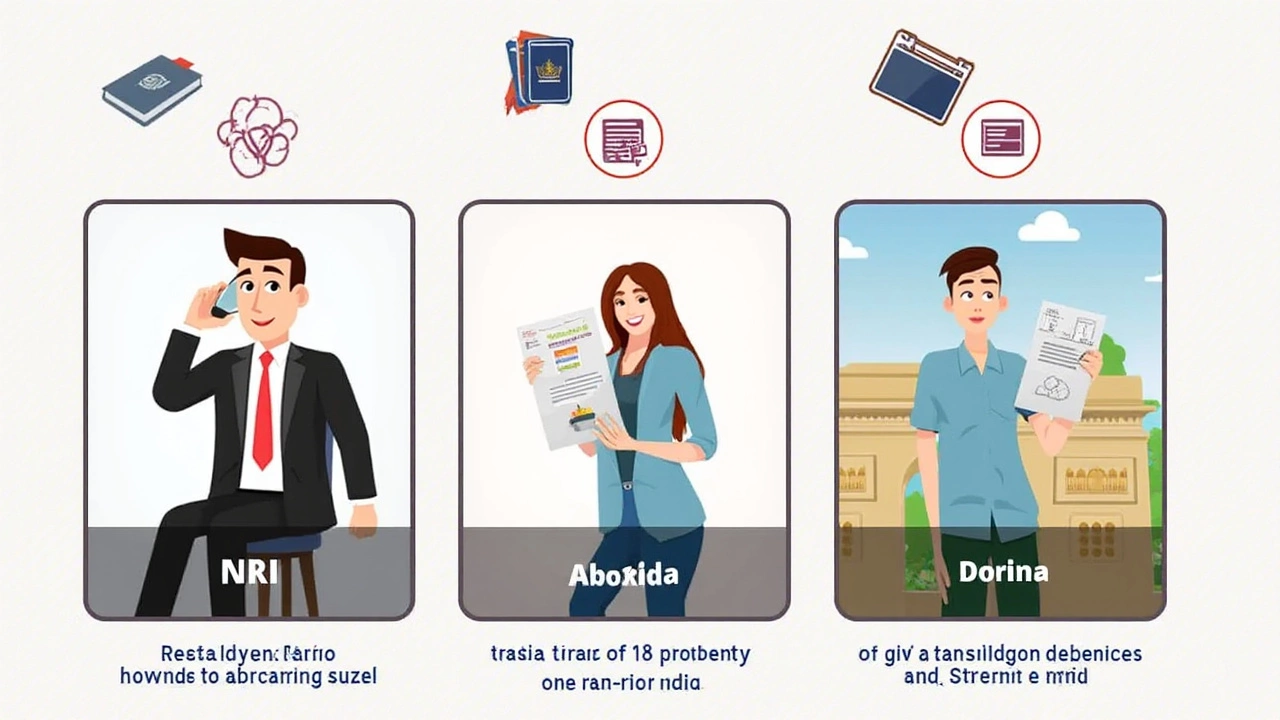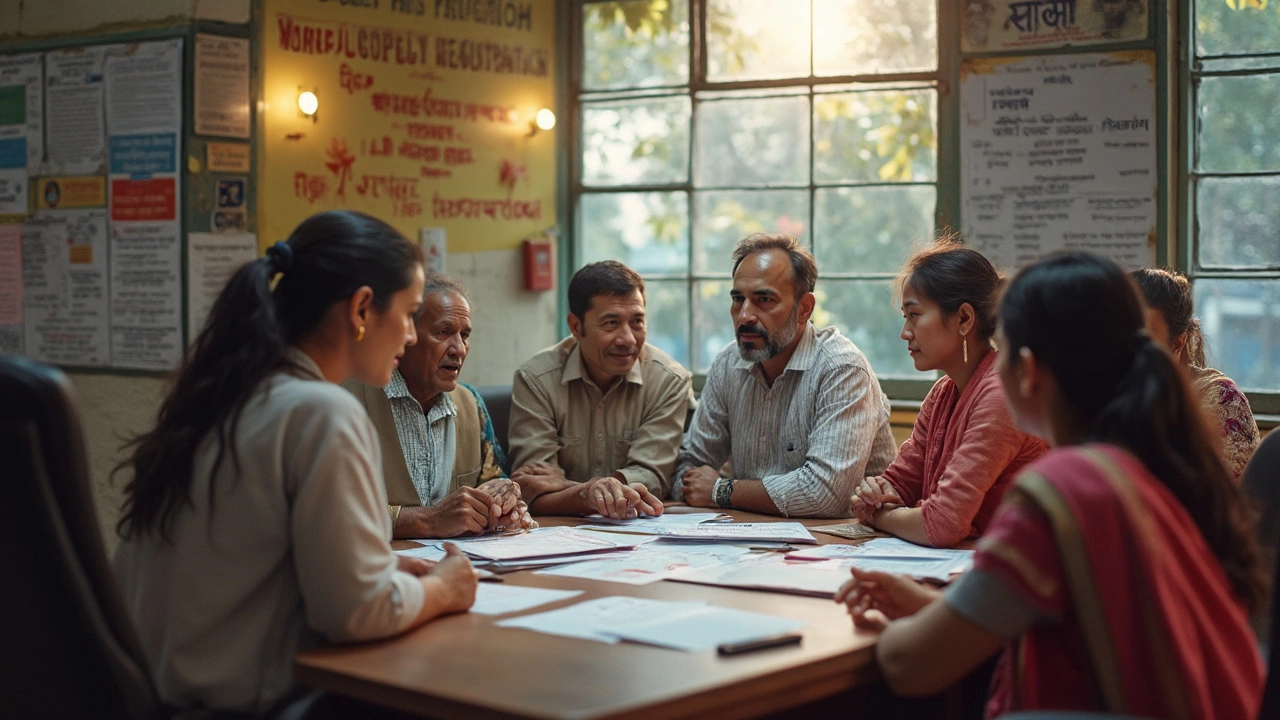Jumping into property registration in India? You'll hear the term 'non-resident' thrown around a lot. But who really counts as a non-resident? This isn't just legal jargon—it impacts what documents you need, how you pay taxes, and whether you can even register property without showing up in person.
Most people think 'non-resident' only means someone who lives abroad, but it’s not that simple. For property registration, it includes NRIs (Non-Resident Indians), foreign citizens, and often, people who just spend more time outside India than inside. Yep, even that cousin who moved to Dubai for a job might count.
If you’re in this group—or dealing with someone who is—understanding the exact rules can save you from some wild goose chases. Details like this decide if you need extra paperwork or have to get documents attested at an Indian embassy instead of a local office. Stick around as we sort through the types, the practical steps, and real examples that’ll make your head stop spinning.
- What Does 'Non-Resident' Actually Mean?
- Common Examples of Non-Residents in Property Deals
- Paperwork and Rules for Non-Residents
- Tips for Smooth Property Registration as a Non-Resident
What Does 'Non-Resident' Actually Mean?
This question trips up a lot of people. When you see 'non-resident' on property forms in India, don’t just think of foreigners. It’s a legal label that has clear definitions tied to specific rules—especially the Foreign Exchange Management Act (FEMA) and income tax laws.
If you’re a person living outside India for more than 182 days in a financial year, you tick the non-resident box, even if you have an Indian passport. The Indian government says it’s all about your physical presence, not the color of your passport.
- Non-Resident Indian (NRI): This is an Indian citizen who stays abroad for work, business, or any reason, for at least 182 days during the financial year.
- Person of Indian Origin (PIO): Anyone with Indian roots (parents or grandparents), but holding a foreign passport.
- Foreign Citizen: This includes people with absolutely no Indian connections staying outside India.
Here’s a quick breakdown that might help if you’re still not sure:
| Type | Days Spent Outside India | Property Rights |
|---|---|---|
| NRI | 182 days or more | Can buy/sell certain properties |
| PIO | Often lives abroad | Similar rights as NRI |
| Foreign Citizen (Non-Indian Origin) | Any | Restricted properties, mostly with RBI consent |
This stuff matters because if you’re marked as a non-resident, the rules around buying, selling, or inheriting property change. You’ll face different taxes, paperwork, and sometimes even extra clearances. RBI looks closer at non-resident deals to stop money laundering and keep the paperwork fair.
One thing people overlook: different rules for FEMA and income tax. It’s possible to be an NRI for RBI's rules and still be taxed as a resident, or vice versa. If the paperwork feels confusing, you're definitely not alone!
Common Examples of Non-Residents in Property Deals
This is where things get interesting. ‘Non-resident’ isn’t just a fancy label—they're real people in everyday situations. Let’s break down who shows up as a non-resident when you’re dealing with property registration in India.
First up, there are Non-Resident Indians (NRIs). They’re Indian citizens, but they live, work, or study outside India for at least 182 days in a financial year. If your friend Raj from London wants to buy a flat in Mumbai, he’s counted as an NRI for property registration.
Then come OCI cardholders. OCI stands for Overseas Citizen of India—a status given to people with Indian heritage but foreign citizenship, like a US or UK passport. They’re not technically Indian citizens, but India lets them buy and register most types of property, except farmland.
Another group is foreign nationals. These are people with no Indian heritage or citizenship who want to own property in India—rare, except for business or investment reasons. India’s rules are strict here; in most cases, a foreigner with a tourist visa isn’t allowed to register residential property, but there are exceptions for business visa holders and others with long-term visa types.
Here’s a quick comparison to clear things up:
| Type | Who are they? | Property Rights |
|---|---|---|
| NRI | Indian citizen living overseas | Can buy most property types (not farmland) |
| OCI | Foreign citizen of Indian origin | Can buy most property types (not farmland) |
| Foreign National | Foreigner with no Indian roots | Can rarely buy (with special visas only) |
And just for the record, even an Indian citizen living outside India for years, if they crossed that 182-day rule, they’re tagged as an NRI. One year can flip your ‘resident’ status, and suddenly, property paperwork gets more complicated.
- NRIs and OCIs need their passports and address proofs abroad for paperwork.
- Foreign nationals usually need special government permission for anything beyond a lease.
- Being a non-resident doesn’t mean you can’t buy property, but it does mean extra steps and more scrutiny.
So, if you or someone you know fits into these boxes, brace for some different rules at the registrar’s office—and don’t skip checking the exact requirements before jumping in.

Paperwork and Rules for Non-Residents
If you’re a non-resident looking to register property in India, be ready for paperwork that’s a step above what locals handle. The system is strict about documents, and missing one detail can get your application stuck for weeks.
First, proof of identity is non-negotiable. A valid passport is almost always required. If you’re an NRI, your Indian passport works. If you’re a foreign citizen, your country’s passport plus Indian visa or OCI/PIO card does the trick.
Second, you’ll need proof of overseas address. This can be a utility bill, bank statement, or government-issued card, but it must clearly show your name and current address outside India. Any document not in English or Hindi needs an official translation.
Next up is PAN—Permanent Account Number. You need this to deal with taxes during property transactions. If you don’t have one, you’ll need to get it ahead of time, or else prepare to pay extra TDS (tax deducted at source), sometimes at a higher rate.
Here’s what to expect in the typical paperwork bundle for a property purchase or sale:
- Passport and visa/OCI/PIO card (originals and copies)
- Address proof (overseas and Indian, if possible)
- PAN card
- Recent passport-sized photos
- Sale agreement or property papers
- Power of Attorney, if you can’t be present in India (must be signed in front of an Indian embassy official and sent to India, then adjudicated at a local collector’s office)
Also, remember: signatures have to match exactly with your ID documents. Even a small mismatch leads to trouble at the registration office. For big payments, banks might ask for proof of inward remittance from your overseas account to India. This is to show that you’re not skirting India’s rules on foreign money.
A practical tip: double-check the registration office’s requirements before you fly in or mail documents. These rules can differ slightly from state to state, and while the basics look the same, one extra set of photocopies—or the lack of an embassy stamp—can waste days.
Tips for Smooth Property Registration as a Non-Resident
No one likes running into roadblocks with property registration, especially if you live outside India. Let’s get into some practical tips that actually make a difference for a non-resident.
- Get your PAN Card sorted early. Every non-resident buying or selling property in India needs a PAN card. Without it, you can’t pay taxes or get your property registered. Apply online if you don’t have one—it saves a ton of time.
- Use a reliable Power of Attorney (PoA). If you can’t show up in person, you’ll need a PoA. It should be specific (for property registration only), notarized, and attested at the Indian embassy in your country of residence. Double-check if the local Sub-Registrar Office in India has any unusual format requirements.
- Bank accounts matter. Money for property payments must come through NRE/NRO/FCNR accounts. This isn’t just bank speak—the registration office wants proof of legal money trails. Ask your bank for a statement showing the source of funds before you hit the registration desk.
- Budget for TDS. If a non-resident is the seller, the buyer must deduct TDS (Tax Deducted at Source)—usually 20% or more—before paying the seller. That’s not a small sum, so factor it into your calculations.
- Document checklist is your friend. Missing one paper can mess up everything. Prepare copies of passport, visa or OCI card, address proof (even if it’s outside India), and bank documents. Some states in India now accept digital documents, but most still want paper copies and original signatures.
- Keep an eye on timelines. Most property registrations need to happen within four months of signing the sale agreement. Miss that window, and you’ll be paying penalties or, worse, risking the deal entirely.
| Document | Purpose | Any Special Steps? |
|---|---|---|
| PAN Card | Tax compliance | Apply online if you don’t have one |
| Passport/OCI | Proof of identity, NRI status | Carry original and copies |
| Power of Attorney | If not physically present for signing | Get attested at Indian embassy abroad |
| Bank account details (NRE/NRO/FCNR) | Proof of legal funds | Latest statements needed |
| Address proof (foreign or Indian residence) | Current residence validation | Even utility bills or bank letters may work |
Here’s a pro tip: before you finalize the sale, call the Sub-Registrar’s office and ask for their latest document list. Some states randomly update their rules, and there’s nothing more annoying than missing one new requirement because an old checklist led you astray.
If you’re selling, be ready to receive the payment through proper banking channels only. Cash isn’t just frowned upon—it can get your registration denied or attract legal trouble. Always confirm the payment method with your bank and the buyer in advance. Nothing ruins a deal like scrambled last-minute money transfers.
And finally, get digital where you can. More states in India are allowing e-signatures or digital uploads for some parts of the registration process. That doesn’t mean everything is online, but every small convenience helps when you’re far from home.





